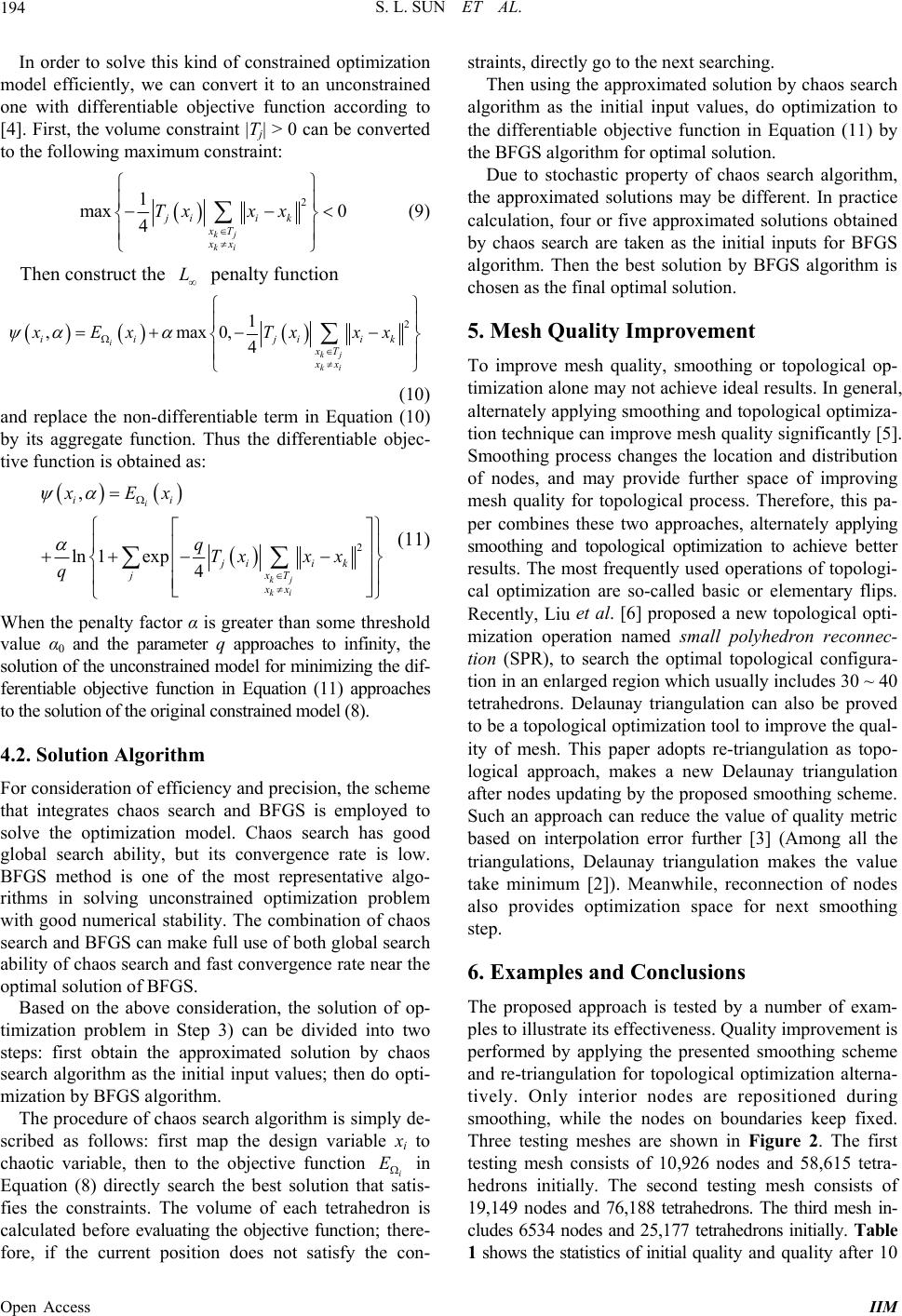
S. L. SUN ET AL.
Open Access IIM
194
In order to solve this kind of constrained optimization
model efficiently, we can convert it to an unconstrained
one with differentiable objective function according to
[4]. First, the volume constraint |Tj| > 0 can be converted
to the following maximum constraint:
2
1
max 0
4kj
ki
jii k
xT
xx
Txx x
(9)
Then construct the L penalty function
2
1
,max0,
4
i
kj
ki
ii jiik
xT
xx
xExTx xx
(10)
and replace the non-differentiable term in Equation (10)
by its aggregate function. Thus the differentiable objec-
tive function is obtained as:
2
,
ln 1exp4
i
kj
ki
ii
jii k
jxT
xx
xEx
qTxx x
q
(11)
When the penalty factor α is greater than some threshold
value α0 and the parameter q approaches to infinity, the
solution of the unconstrained model for minimizing the dif-
ferentiable objective function in Equation (11) approaches
to the solution of the original constrained model (8).
4.2. Solution Algorithm
For consideration of efficiency and precision, the scheme
that integrates chaos search and BFGS is employed to
solve the optimization model. Chaos search has good
global search ability, but its convergence rate is low.
BFGS method is one of the most representative algo-
rithms in solving unconstrained optimization problem
with good numerical stability. The combination of chaos
search and BFGS can make full use of both global search
ability of chaos search and fast convergence rate near the
optimal solution of BFGS.
Based on the above consideration, the solution of op-
timization problem in Step 3) can be divided into two
steps: first obtain the approximated solution by chaos
search algorithm as the initial input values; then do opti-
mization by BFGS algorithm.
The procedure of chaos search algorithm is simply de-
scribed as follows: first map the design variable xi to
chaotic variable, then to the objective function i
E
in
Equation (8) directly search the best solution that satis-
fies the constraints. The volume of each tetrahedron is
calculated before evaluating the objective function; there-
fore, if the current position does not satisfy the con-
straints, directly go to the next searching.
Then using the approximated solution by chaos search
algorithm as the initial input values, do optimization to
the differentiable objective function in Equation (11) by
the BFGS algorithm for optimal solution.
Due to stochastic property of chaos search algorithm,
the approximated solutions may be different. In practice
calculation, four or five approximated solutions obtained
by chaos search are taken as the initial inputs for BFGS
algorithm. Then the best solution by BFGS algorithm is
chosen as the final optimal solution.
5. Mesh Quality Improvement
To improve mesh quality, smoothing or topological op-
timization alone may not achieve ideal results. In general,
alternately applying smoothing and topological optimiza-
tion technique can improve mesh quality significantly [5].
Smoothing process changes the location and distribution
of nodes, and may provide further space of improving
mesh quality for topological process. Therefore, this pa-
per combines these two approaches, alternately applying
smoothing and topological optimization to achieve better
results. The most frequently used operations of topologi-
cal optimization are so-called basic or elementary flips.
Recently, Liu et al. [6] proposed a new topological opti-
mization operation named small polyhedron reconnec-
tion (SPR), to search the optimal topological configura-
tion in an enlarged region which usually includes 30 ~ 40
tetrahedrons. Delaunay triangulation can also be proved
to be a topological optimization tool to improve the qual-
ity of mesh. This paper adopts re-triangulation as topo-
logical approach, makes a new Delaunay triangulation
after nodes updating by the proposed smoothing scheme.
Such an approach can reduce the value of quality metric
based on interpolation error further [3] (Among all the
triangulations, Delaunay triangulation makes the value
take minimum [2]). Meanwhile, reconnection of nodes
also provides optimization space for next smoothing
step.
6. Examples and Conclusions
The proposed approach is tested by a number of exam-
ples to illustrate its effectiveness. Quality improvement is
performed by applying the presented smoothing scheme
and re-triangulation for topological optimization alterna-
tively. Only interior nodes are repositioned during
smoothing, while the nodes on boundaries keep fixed.
Three testing meshes are shown in Figure 2. The first
testing mesh consists of 10,926 nodes and 58,615 tetra-
hedrons initially. The second testing mesh consists of
19,149 nodes and 76,188 tetrahedrons. The third mesh in-
cludes 6534 nodes and 25,177 tetrahedrons initially. Table
1 shows the statistics of initial quality and quality after 10